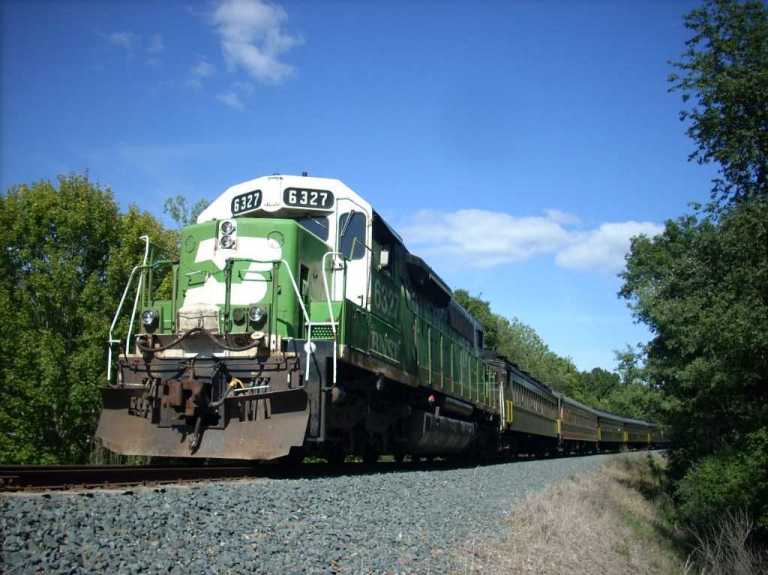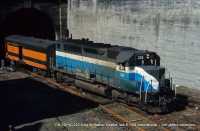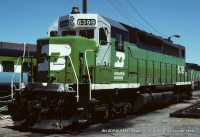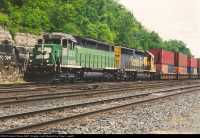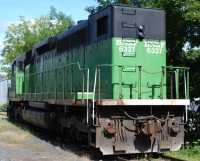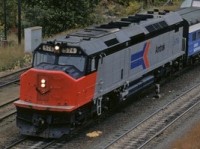 |
||||||||||||||||||||||||||||||||||||||||||||||||||||||||||||||||||||||||||||||||||||||||||||||||||||||||||||
BNSF 6327SDP40 PASSENGER ROAD LOCOMOTIVE
In May 2009, the BNSF Railway donated SDP40 6327 to the Minnesota Transportation Museum. She was built in 1966 as Great Northern 325 for passenger service between St Paul, MN and the Pacific Northwest. Historical SignificanceMTM requested this locomotive because it is historically significant in several ways:
It is also notable because:
GN 325's HistoryThe Great Northern railroad believed that passenger trains were the window through which the public viewed them. It should either be keep washed and cleaned, or shut altogether. Although jet air travel and the new interstate highway system had encroached on patronage and profits, and some railroads had terminated all passenger service, in 1966 the GN's main passenger trains were still viable. One problem was the passenger locomotives. Averaging over twenty years old, they were costing more and more to keep in good repair. In May 1966 the GN purchased six 3000-hp SDP40s for the Western Star and connecting trains to Vancouver, BC and Portland, OR. They were numbered 320-325, used EMD's new improved 645 diesel engine, and were painted in "simplified" orange and green Empire Builder colors. Havre, MT was their assigned maintenance base. Around the same time, the railroad's own shops created ten steam heat cars which allowed freight locomotives to substitute on passenger trains. Finally, in 1967 the GN purchased eight 3600-hp SDP45s for the Empire Builder, which were numbered 326-333. The SDP40, passenger version of the SD40, contained a Vapor-Clarkson steam generator in an extended long hood that is flat instead of tapered. Vents are present along the side of the steam generator area. The SDP40s were built especially for the GN, and the GN was the only US railroad that purchased the SDP40 model. Only 20 were built, six of GN and 14 for NdeM (National Railways of Mexico). In 1967 the Great Northern embarked on a corporate re-imaging program. Working with St Paul design firm Lippincott & Marguiles, they modernized their logo, adopted the Helvetica typeface for lettering, and corporate colors blue, grey and white - known as Big Sky Blue. The SDP45s were delivered in blue, and all the SDP40s except 323 were eventually repainted. Change came again in March 1970, when the Great Northern, Northern Pacific, Chicago Burlington & Quincy and Spokane Portland & Seattle merged to form the Burlington Northern. The new corporate logo and colors of green, black and white - known as Cascade Green - were designed by the same design firm who had created Big Sky Blue and are very similar. In fact they kept the Helvetica typeface. In the merger, GN 320-325 became BN 9850-9855. Those numbers derive from the Burlington's practice of numbering passenger locomotives. More change arrived in May 1971, when BN transferred its passenger train operations to the newly-formed quasi-Government National Railroad Passenger Corporation - Amtrak. Although BN sold a number of passenger cars to Amtrak, they retained the SDP40s and SDP45s. The steam generators were removed and, redesignated model SD40 by the BN, the SDP40s were again renumbered - this time to 6394-6399. 9855 became 6399 on April 15, 1974. One SDP40 - former GN 323 which never wore Big Sky Blue - was distinguished by being painted in the "Bicentennial" red/white/blue scheme as BN 1976 from 1975 to 1978, in celebration of the United States's 200th birthday. Former GN 325 - MTM's loco - became similarly distinguished in 1989 when BN repainted it with a white cab front and large logo on its nose. This variation of Cascade Green, designed for increased visibility and safety, has been nicknamed the White Face paint scheme. The ex-GN SDP45s were retired in the mid-1980's, during a purge of all V20-powered F45, SD45 and SDP45 locomotives. GN 333/BN 6599 alone survived, in modified form, as a road test of an experimental four-axle self-steering radial truck design. In 1995, the Burlington Northern and the Santa Fe merged to create the Burlington Northern Santa Fe Railway, later known simply as BNSF. Two SDP40s, GN 321 and 322, were already gone. 322 was wrecked and scrapped in 1984, and 321 sold to Montana Rail Link (it survives today as their rebuilt "SDP40-2XR" 290.) GN 320/BN 6394 was owned by BNSF for a year before being scrapped in 1996. That left GN 323-325 to be renumbered BNSF 6325-6327 in 1998. Ex-GN 323 (the "Bicentennial" 1976) was sold to NRE and is now in the Alstom lease fleet as GCFX 3093 painted in an all-white scheme. It has been rebuilt, losing much of its distinctive steam generator compartment and vertical rear steps. Thus BNSF 6326 and 6327 became the final two locomotives on the BNSF to have started life as passenger units. 6326 (nee-GN 324) is actually still on their roster, but has been stored out of service for many years. Interestingly, it's identifcation has been changed to GN 6326 to make way for new locomotive purchases. That left 6327 as the last active passenger unit, until it was retired in June 2008 after 42 years of service and then only due to a surplus motive power situation. It was en route to Galesburg, IL when the retirement order came down. By the time it was moved to Topeka, KS for disposition, it had already been earmarked for donation to MTM. BNSF 6327 still retains its as-built low-hood SDP40 appearance with only a few minor external changes: head light relocated from between the number boards to top of low nose (the only one so modified,) steam generator equipment and roof apparatus removed, ditch-lights added to the front walkway deck, and nose classifications lights removed and plated over. Photo Gallery
For more photos of SDP40's, see RailPictures.Net and RR Picture Archives.net. Specifications
DiagramHere is the SDP40 Locomotive Diagram published by EMD. Interestingly, it does not agree completely with any of the SDP40s actually built. In the Great Northern's case:
Amtrak SDP40F DifferencesGreat Northern bought the SDP40, and Amtrak the SDP40F. Is there any difference?
Sources:
Last updated: 9/2/2009 |
| HOME | JACKSON STREET ROUNDHOUSE | OSCEOLA & ST. CROIX VALLEY RAILWAY | CLASSIC BUSES | MINNEHAHA DEPOT | |
All content contained herein, Copyright © Minnesota Transportation Museum, Inc. |
|||||
